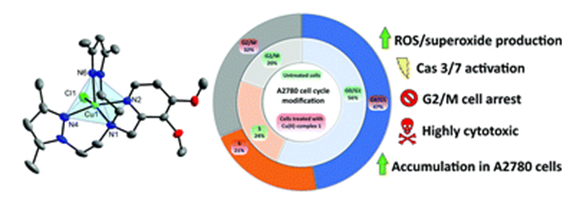Publication in Dalton Transactions
Identification of potent anticancer copper(II) complexes containing tripodal bis[2-ethyl-di(3,5-dialkyl-1H-pyrazol-1-yl)]amine moiety
Authors: Salah S. Massoud, Febee R. Louka, Madison T. Dial, Andrew J. Malek, Roland C. Fischer, Franz A. Mautner, Ján Vančo, Tomáš Malina, Zdeněk Dvořák and Zdeněk Trávníček
Full-text https://doi.org/10.1039/D1DT01724A

A series of heteroleptic copper(II) complexes of the composition [Cu(L1–5)Cl]X, containing tripodal pyrazolyl amines (L1–5) and X = ClO4 and/or PF6, was prepared and thoroughly characterized including single-crystal X-ray diffraction. The in vitro cytotoxicity of the complexes against the A2780, A2780R, HOS and MCF-7 human cancer cell lines was evaluated using the MTT test. The results revealed that complexes [Cu(L1)Cl]PF6 (1-PF6), [Cu(L2)Cl]ClO4 (2-ClO4) and [Cu(L3)Cl]PF6 (3-PF6) to be the most effective, with the IC50 values ranging from 1.4 to 6.3 mM, thus exceeding the cytotoxic potential of metallodrug cisplatin (IC50 values ranging from 29.9 to 82.0 mM). The complexes [Cu(L4)Cl]PF6 (4-PF6) and [Cu(L5)Cl]PF6 (5-PF6) showed only a moderate cytotoxicity against A2780, with IC50 = 53.6 mM, and 33.8 mM, respectively. The cell cycle profile, time-resolved cellular uptake, interactions with small sulfur-containing biomolecules (cysteine and glutathione), intracellular ROS production, induction of apoptosis and activation of caspases 3/7 were also evaluated in the case of the selected complexes. It has been found that the best performing complexes 1 and 2 cause the cell arrest in the G2/M phase and induce apoptosis via increase in production of ROS, dominantly due to overproduction of superoxide.


